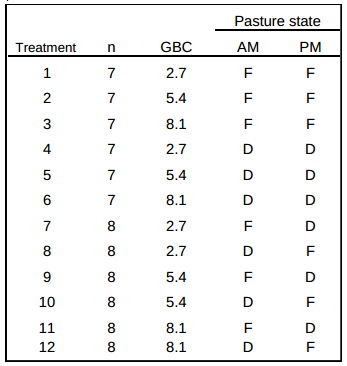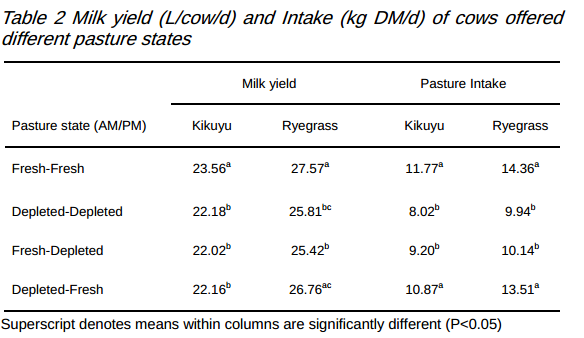



How Does Grain-based Concentrate Allocation and Pasture State Impact Intake and Milk Production in Dairy Cows Grazing Kikuyu and Ryegrass Pasture?
Constant access to fresh pasture is best, says an Australian researcher after scrutinising grazing and grain based concentrate diets in lactating cows.Low DM intake is a major limitation to milk production in pasture-based systems and pasture alone is insufficient to maximise production potential of dairy cows, writes Ravneet Kaur at Sydney University's Faculty of Veterinary Science. Allocation of grain-based concentrate (GBC) to dairy cows based on individual cow requirements, rather than on a herd basis at a fixed rate increased milk solids yield by ~7% in a short term study (Garcia et al. 2007).
This benefit was speculated to be due to improvements in the balance of the diet as cows that ate more NDF primarily in the form of maize silage also ate more concentrate. In pasture-based automatic milking systems (AMS), due to the voluntary cow traffic and distribution of milking, dairy cows arrive at pasture at varying stages of depletion so that some cows access high quality fresh pasture compared to other cows which access low quality (higher NDF) depleted, higher NDF pasture (already grazed by other cows).
Further, in AMS systems, GBC have been allocated independently of the pasture state. To date, the ability to increase feed conversion efficiency and AMS herd milk production by targeted GBC supplementation to cows grazing differing pasture states is unknown. Therefore, the objective of the current experiment was to determine the impact of kikuyu and ryegrass pasture state and GBC allocation on dairy cow intake and milk production.

A group of 90 Holstein-Friesian cows were offered combination of four different pasture states and three different amounts of GBC (Table 1).
Pasture states comprised of either two consistent (namely fresh-fresh, and depleted-depleted) or two inconsistent (namely fresh-depleted, and depleted-fresh) pasture states offered after morning (AM) and afternoon (PM) milking respectively. The GBC was offered half in the morning (AM) and half in the afternoon (PM) milking. Further, 3 cows within each of the 12 treatments (total of 36 cows in the herd) were randomly selected and dosed with synthetic alkanes to determine pasture intake.
Rectal grab samples were collected twice daily after milking for 7 consecutive days and analysed for alkane content to determine pasture intake. Data were analysed using linear mixed modelling in GenStat 14th Edition (VSN International, UK). The statistical model included the interaction between pasture and concentrate, using pre-experimental milk yield as a covariate. Cow and day were included as a random effect. Significance was determined if P < 0.05.
Kikuyu trial: There was an increase in milk production with increased GBC and there were differences in milk production with pasture state (Table 2 and 3). For cows accessing fresh, fresh pasture, there was 1.44 kg more milk produced than other pastures states. There was 1.65 kg more milk produced when GBC increased from 3 to 6 kg DM/d, and 3.01 kg more milk when GBC increased from 3 to 9 kg DM/d.



